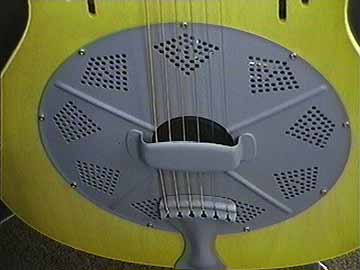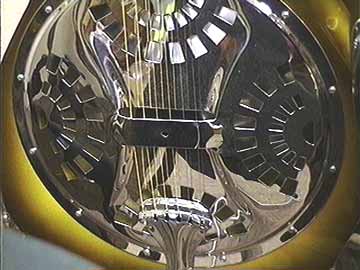Resophonic
© Frank Ford, 10/8/98 Photos by FF
In the late 1920s, using the same basic principal of the vibrating diaphragm of the acoustic phonograph, the wild and crazy Dopyera brothers developed the "resophonic" guitar. The resophonic guitar was the first "amplified" instrument and was especially popular among Hawaiian guitarists and blues players who needed extra volume. Resophonic guitars are frequently called "resonator guitars." They may have wooden or metal bodies.
The simplest resophonic instrument has a wooden bridge sitting right on top of an aluminum cone:

The energy of the vibrating strings drives the cone just like a speaker cone.
The delicate resophonic cone has a cover plate to protect it from damage:

The cover plate has a place to rest your palm so you don't damage or damp the cone:

This is a Dobro style guitar with a "spider" bridge

It's hard to see under the cover plate, but this guitar has a cast aluminum "spider" that holds up the bridge and connects to an aluminum cone hanging down inside the body:

Here's a resophonic guitar made with three small cones connected by a cast aluminum bridge:
Talk about Art Deco styling! This is the famous National Tricone. If you look closely, beneath the screens you can see the edges of the three small cones.
Back to Glossary
Back to Index Page